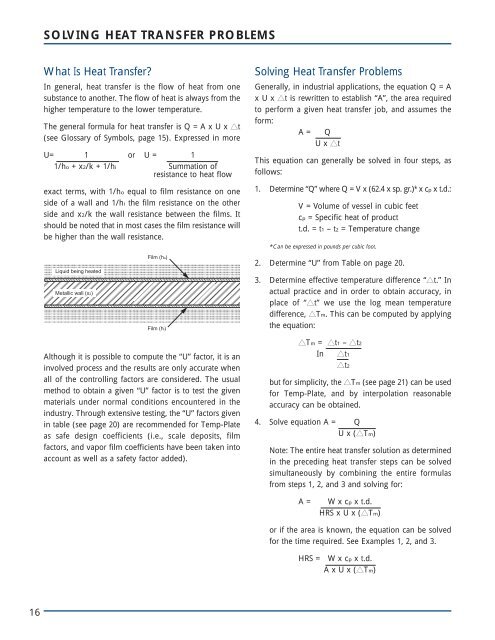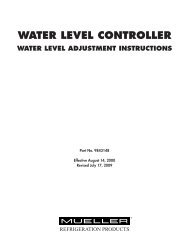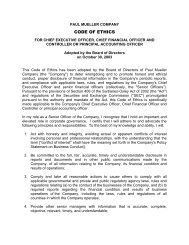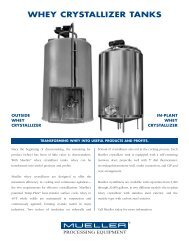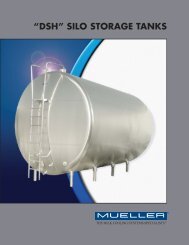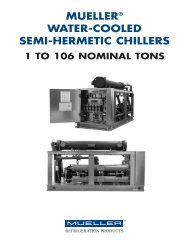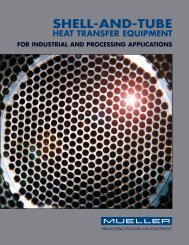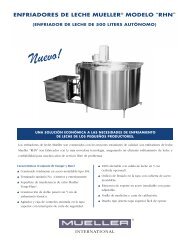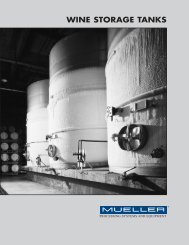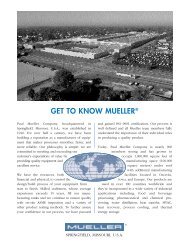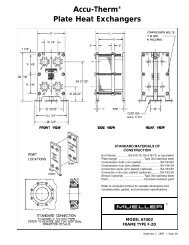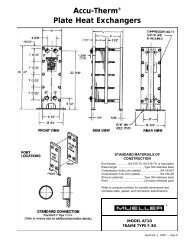ALL ABOUT TEMP-PLATE® - Paul Mueller Company
ALL ABOUT TEMP-PLATE® - Paul Mueller Company
ALL ABOUT TEMP-PLATE® - Paul Mueller Company
Create successful ePaper yourself
Turn your PDF publications into a flip-book with our unique Google optimized e-Paper software.
16<br />
SOLVING HEAT TRANSFER PROBLEMS<br />
What Is Heat Transfer?<br />
In general, heat transfer is the flow of heat from one<br />
substance to another. The flow of heat is always from the<br />
higher temperature to the lower temperature.<br />
The general formula for heat transfer is Q = A x U x ▲t<br />
(see Glossary of Symbols, page 15). Expressed in more<br />
U= 1 or U = 1<br />
1/ho + x2/k + 1/hi Summation of<br />
resistance to heat flow<br />
exact terms, with 1/ho equal to film resistance on one<br />
side of a wall and 1/hi the film resistance on the other<br />
side and x2/k the wall resistance between the films. It<br />
should be noted that in most cases the film resistance will<br />
be higher than the wall resistance.<br />
Liquid being heated<br />
Metallic wall (x2)<br />
Film (ho)<br />
Film (hi)<br />
Although it is possible to compute the “U” factor, it is an<br />
involved process and the results are only accurate when<br />
all of the controlling factors are considered. The usual<br />
method to obtain a given “U” factor is to test the given<br />
materials under normal conditions encountered in the<br />
industry. Through extensive testing, the “U” factors given<br />
in table (see page 20) are recommended for Temp-Plate<br />
as safe design coefficients (i.e., scale deposits, film<br />
factors, and vapor film coefficients have been taken into<br />
account as well as a safety factor added).<br />
Solving Heat Transfer Problems<br />
Generally, in industrial applications, the equation Q = A<br />
x U x ▲t is rewritten to establish “A”, the area required<br />
to perform a given heat transfer job, and assumes the<br />
form:<br />
A = Q<br />
U x ▲t<br />
This equation can generally be solved in four steps, as<br />
follows:<br />
1. Determine “Q” where Q = V x (62.4 x sp. gr.)* x cp x t.d.:<br />
V = Volume of vessel in cubic feet<br />
cp = Specific heat of product<br />
t.d. = t1 –t2 = Temperature change<br />
*Can be expressed in pounds per cubic foot.<br />
2. Determine “U” from Table on page 20.<br />
3. Determine effective temperature difference “▲t.” In<br />
actual practice and in order to obtain accuracy, in<br />
place of “▲t” we use the log mean temperature<br />
difference, ▲Tm. This can be computed by applying<br />
the equation:<br />
▲Tm = ▲t1 – ▲t2<br />
In ▲t1<br />
▲t2<br />
but for simplicity, the ▲Tm (see page 21) can be used<br />
for Temp-Plate, and by interpolation reasonable<br />
accuracy can be obtained.<br />
4. Solve equation A = Q<br />
U x (▲Tm)<br />
Note: The entire heat transfer solution as determined<br />
in the preceding heat transfer steps can be solved<br />
simultaneously by combining the entire formulas<br />
from steps 1, 2, and 3 and solving for:<br />
A = W x cp x t.d.<br />
HRS x U x (▲Tm)<br />
or if the area is known, the equation can be solved<br />
for the time required. See Examples 1, 2, and 3.<br />
HRS = W x cp x t.d.<br />
A x U x (▲Tm)


